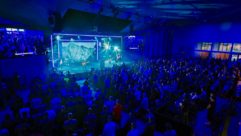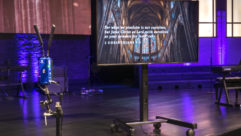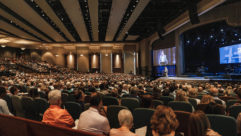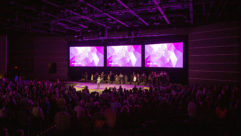
Church Installs Versatile AV
A church in Jacksonville, FL, adds multipurpose AV to accommodate the different acoustical demands of various events.
CHALLENGE: Create an easy-to-use yet budget-conscious AV environment capable of supporting basketball games, meetings, and worship services — all in a single space.A digital approachWall treatmentFuture-ready AV
The gymnasium in the new Family Life Center at the Grace Lutheran Church in Jacksonville, FL, includes Econo-Wedge acoustical paneling from Perdue Acoustics to increase the intelligibility and reduce the reverberation time in the room.
SOLUTION: Use an in-house team to install a digital audio snake, a mixing console, and add extensive acoustical treatments to the space.
UNFORESEEN EXPANSION in the past three years caused the Grace Lutheran Church in Jacksonville, FL, to rapidly outgrow its facility. As a result of the expansion, a fellowship hall that had been used for gym classes and meetings had to be converted into new classrooms. With its multipurpose space gone, the church began planning a new building to accommodate its wide range of needs.
Once the new Family Life Center’s specifications were determined in November 2004, the church turned its attention to the AV system. Although the building included a kitchen and small meeting and classrooms, the AV system would be confined to the large gymnasium that occupied the majority of the building’s space. Grace Lutheran’s congregational audio engineer Rick Charlton and congregation president Craig Boesdorfer envisioned a fully functional gymnasium that would also be acoustically capable of producing high-quality sound and intelligibility for other events.
To help make their vision a reality, Charlton turned to Bruce Lee, owner of Jacksonville-based AV design-build firm Pro AV Inc. Charlton chose Lee because the two had worked together on the successful redesign of Grace Lutheran’s main sanctuary a few years prior. Charlton also selected Lee because Charlton felt comfortable installing the larger, more labor intensive AV components the project required, and knew that Lee often recommends that clients perform the majority of the more costly installation work on their own.
“We’re one of the few companies that encourages churches to install the system themselves,” Lee says. “We tell them what to do and how to do it. Then we come back and make sure they installed everything to specifications. I think people make too much out of installation sometimes. If you do it right, it isn’t coming down. It also lets them install a much better sound system than if they paid $15,000 or more to have someone install it for them.”
A set of three Apogee AFI-8 loudspeakers provides the audio for the multipurpose facility in the Grace Lutheran Church’s Family Life Center. The loudspeakers’ placement was specified using EASE modeling.
Credit: aland
Because the church planned to complete the AV installation using volunteers and Charlton’s supervision, Lee wanted to design a system that would be as simple to install as possible.
Lee and Charlton decided on a system that would include three selectable audio options: one to accommodate overhead announcements during athletic events, one to support music and microphones for meetings and events, and a third option that would use a digital audio mixer to provide greater audio performance control for contemporary worship services and live performance events.
To program and enable easy selection of any of the three audio system configurations, Lee installed a Biamp Nexia PM processor with Biamp’s Volume/Select 8 user control option, which allows users to toggle between configurations and make adjustments.
The Biamp Nexia PM processor also serves two other distinct roles in the system. In the first configuration option, microphones or audio sources are plugged directly into the Nexia PM unit, which acts as a standalone automatic mixer. In the more complex second and third configurations where the digital audio mixer is activated, the Nexia PM functions as a signal processor for the loudspeakers, handling equalization, delay, and crossover capabilities.
All configurations utilize a floor box, which Lee was able to quickly install during the construction phase. The floor box includes XLR and RCA inputs for microphones and secondary audio sources, such as CD players.
The first configuration uses only one of the three Apogee AFI-8 loudspeakers that Charlton installed hanging from the ceiling of the gymnasium. The loudspeaker placement was selected based on Lee’s EASE modeling, which accounted for direct sound coverage and reverberation time considerations.
LEVELS OF EASE
For the multipurpose Family Life Center facility at the Grace Lutheran Church in Jacksonville, FL, Bruce Lee, project manager and owner of Jacksonville-based AV design-build firm Pro AV Inc., used EASE acoustical modeling software from Renkus-Heinz to determine the loudspeaker placement and necessary acoustical wall treatments.
While “using EASE” has become a ubiquitous phrase, it can mean anything from a three-minute direct sound coverage reading to a day-long study of a room’s acoustical properties.
Carl Dorwaldt, marketing associate at Renkus-Heinz, says that EASE can be used in different levels of complexity, depending on the needs of the job, but that users often only scratch the surface of what EASE can do. Dorwaldt describes EASE Level 1 as a tool that will allow users to get a quick idea of the room’s general loudspeaker requirements. He says Level 1 is most sufficient “when someone wants to know if what he has in mind is going to work,” he says.
And while Level 2 is more complex — including building a complete room model and adding acoustical treatment products — both levels don’t use many of the options available within the program.
For example, Dorwaldt says, “the third level involves ray tracing — the study of the propagation of sound rays into the room to calculate local RT times and impact studies — which provide for the detailed investigation of reflections that hit a specific location within a model to better understand the disturbances,” he says.
However, one thing that EASE doesn’t account for is scattering or diffusion. But the EASE AURA (Analysis Utility for Room Acoustics) add-on module enables users to simulate, look at, and account for scattering and diffusion. AURA also offers auralization, which lets the user hear what a room will sound like from a particular seat location.
The second configuration, which is primarily used for meetings and youth group events, activates all three Apogee loudspeakers. To accompany the audio, an Eiki LC-X50M projector was mounted on the ceiling, along with a 9-foot by 12-foot Da-Lite Electrol Tensioned projection screen installed above the stage area on one side of the gym. The church uses the projector to display PowerPoint presentations and song lyrics during contemporary services.
The third audio configuration, which also uses all three Apogee loudspeakers, is designed for worship services and live performance events. Selecting this option on the Biamp Nexia system activates a 9-pin D-sub connector located in the floor box, which connects to a Yamaha 01V96v2 digital audio mixer.
“We can do equalization and gain control with the mixer board,” Charlton says. “It allows us to select groups if we have a band come in, or select four or five mics for the choir or the pastor’s lapel mic.”
The Yamaha mixer also provides added convenience when it’s used for school plays and musicals. “They can set up scenes for each different change in the play or set up gates to cut microphones on and off for dramatic effect,” Lee says. “If they have a weekday rehearsal, they can save their scenes and recall them on Sunday morning or whenever the performance is.”
However, using the Yamaha digital console instead of an analog console meant that Lee would have to purchase external mic preamps. Keeping that and the need to simplify the installation process in mind, Lee decided to try the RSS Systems S-4000 Digital Audio Snake, which includes the S-4000H front of house unit and the S-4000S stage unit. Lee had heard about the product, but hadn’t yet had the opportunity to use it.
According to Lee and Charlton, the Family Life Center installation was the first in North America to use the RSS digital snake, which Lee admits, initially made him a bit apprehensive. So, to ensure that the product would fit the bill, Lee developed a relationship with RSS’ National Sales Director Doug Swan, and tested the digital snake at his audio studio.
Lee says the digital snake drastically cut back the amount of labor and cable pulling an analog system would have required because it sends all audio signals over a single Cat5e cable to the Apogee loudspeakers.
The digital snake also includes XR-1 remote-controllable mic preamps, so the extra cost of the digital system was nearly offset by eliminating the need to purchase additional mic preamps. The system requires 32 channels, so the church would have had to purchase 16 extra mic preamps to go with the 12 the Yamaha mixer includes.
The positioning of the loudspeakers and the mixer’s capabilities improved the facility’s audio performance, but the large gym space — a square room with hard floors and hard walls — still posed acoustical problems. Lee refers to the space as a “gymnasanctorium” because it functions as both a gymnasium and a sanctuary. These physical characteristics made events other than basketball an acoustical nightmare, so Lee worked with Jacksonville-based acoustical consultant and manufacturer Perdue Acoustics to alter the acoustical properties of the room.
FOR MORE INFORMATION
Apogee
www.apogeesound.com
Biamp
www.biamp.com
Crown
www.crownaudio.com
Da-Lite
www.da-lite.com
EASE
www.renkus-heinz.com
Eiki
www.eiki.com
Perdue Acoustics
www.perdueacoustics.com
Raxxess
www.raxxess.com
RSS
www.rssamerica.com
Yamaha
www.yamaha.com
“In a gymnasium, your biggest issues are RT60, reverberation time, and flutter echoes,” Lee says. “We used the EASE program to help design the acoustical treatment of the room. We used about 60 Perdue Acoustics Econo-Wedge diffsorber panels, including 4x8s, 4x6s, and 4x4s. The RT60 started out at 5 or 6 seconds, and we took it down to about 1.6 or 1.7 seconds.”
The Econo-Wedge panels are angled, which changed the physical shape of the walls to give them more varied surface areas to reflect the sound. Including design, products, and installation, the cost of the acoustical treatments came to about $42,000. Although the treatments were added mainly for worship services and guest speakers, they’re equally beneficial for sporting events.
“The big issue in the untreated rooms where they play basketball is that the players can’t understand the coaches because the acoustics are so bad,” Lee says. “So when we take a building and treat it this way to make it really great for performances and speech, it’s also great for basketball because it’s not so reverberant that it over-amplifies the crowd noise.”
Charlton says that further AV or construction expansion plans currently only include possibly installing a transmitter in the new building to extend a Williams FM hearing assistance system from the main sanctuary. However, that didn’t stop Lee from designing the new AV system around more comprehensive expansion, should the need arise in the future.
“Ideally, a second set of speakers would be hung, but that hasn’t been done yet,” Lee says. “But we did design the system so that could happen in the future.”
Besides upgrading the digital snake system’s software, Charlton says the system has worked flawlessly since the building opened in November 2005.
Paul Kramer is associate editor of Pro AV magazine. He can be reached at [email protected].










